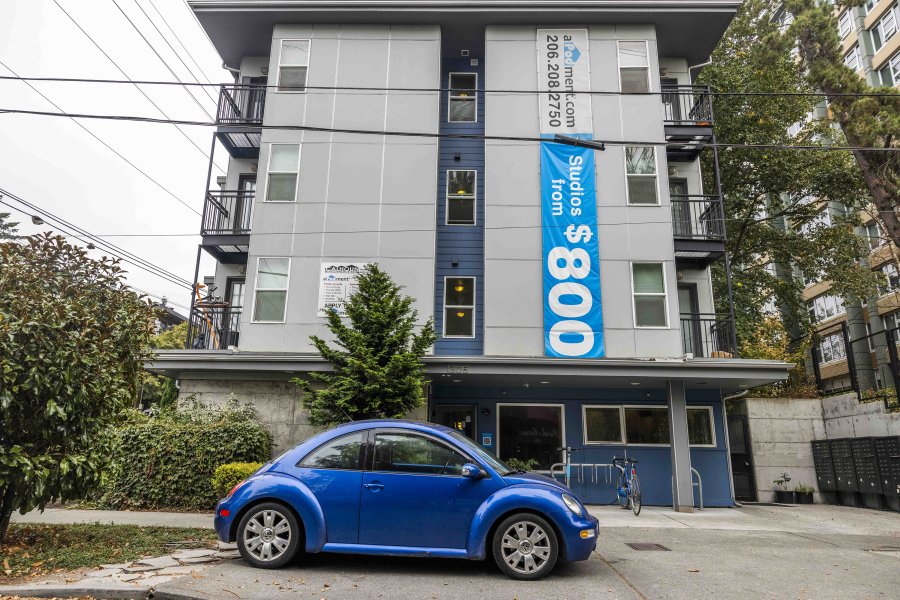SEATTLE—The financial stability of hundreds of Seattle tenants is on the line as public and private players vie for nearly two dozen apartment buildings that have been on the market since this summer.
The entire portfolio of finished aPodment-branded micro-apartment buildings is for sale, a total of 23 properties and 1,402 apartments from Northgate to the Central District. Built by Calhoun Properties, the apartments average 177 square feet and rent for an average of $921, including internet and utilities, according to the brokers listing the buildings. Typical studio and one-bedroom apartments in Seattle go for around $1,500 to $1,700.
As Seattle-area rents have climbed, the apartments offer a rare bit of affordability for some hourly workers. Baristas making the top end of Seattle’s minimum wage, $17.27, could roughly afford the average aPodment rent without spending more than a third of their income, if they were able to work 40 hours a week.
Micro-apartments also come with trade-offs. Some units have kitchenettes, while others have a sink and access to a shared kitchen in the building. Although some apartments are a bit roomier, the most affordable units are more like dorms, with room for a twin bed and desk.
A microhousing boom hit the city nearly a decade ago, but politicians soon cracked down to discourage the smallest units amid a heated debate about density and affordability in the fast-growing city.
Today, as Seattle’s rental market remains expensive and competitive, tenants appear to be making the trade-off. Over the last decade, aPodments saw lower vacancy rates than the overall Seattle apartment market, although more were empty after the pandemic hit in 2020, according to marketing materials for the buildings. Brokers say about 99 percent of the aPodments were occupied this past June.
That demand could present an upside for a private-market buyer: the chance to raise rents. Instead, some hope a nonprofit buyer could keep the rents stable.
Brokers approached the city and Amazon, which funds some affordable housing projects through its Housing Equity Fund, five months ago, said Berkadia managing director Mitchell Belcher, whose company is listing the apartments.
But when the due date for offers arrived in late September, “we didn’t get any offers with city or Amazon involvement,” Belcher said.
“We’ve heard from a mix of market-rate institutional owners, local high-net worth families and local nonprofits,” Belcher said. Most offers have come from for-profit owners, he said.
Brokers have not publicly disclosed a list price. Comparable properties have sold for an average $8.3 million each, they say.
One local nonprofit, the Low Income Housing Institute, is interested in buying several of the buildings.
“There has been a focus on housing for homeless people. Frankly, there is also a terrific need for people who are working at minimum wage and double minimum wage,” Executive Director Sharon Lee said.
Lee said her organization is interested in buying select buildings in the Central District and Capitol Hill to keep the rents at their current levels. However, it’s not yet clear whether the sellers are willing to split up the portfolio.
Lee declined to say how much LIHI offered for which buildings or how much public funding LIHI would need to secure the deal. The nonprofit would likely need both public funding and a private loan to buy the buildings.
“We think it’s important to preserve this as affordable workforce housing,” Lee said.
Others aren’t so sure.
The Seattle Housing Authority got a cold call from a broker about the buildings for sale, but the authority was “not interested,” said spokesperson Kerry Coughlin. The public housing agency is focused on boosting the number of family-sized apartments “because there’s such a dire shortage of that,” rather than very small rentals, Coughlin said.
Beyond that, microhousing rents are already cheaper than typical studio apartments because they’re smaller, making them somewhat more affordable. “We’re better off putting resources into housing that’s threatened to become unaffordable,” Coughlin said.
Bryann Sotomayor has lived in three different aPodment buildings since moving to Seattle about five years ago. The apartments are small but allowed him to afford to live in the city as he worked minimum-wage jobs in customer service, which was crucial because he doesn’t drive.
Recently, he started part-time contract work as a web developer. Although he’s making more per hour, he’s not sure how long the work might last, so he’s still trying to keep his expenses low. The rent for his aPodment on Capitol Hill recently increased from $975 to $1,025, he said.
“I have looked sometimes and haven’t found a cheaper place,” Sotomayor said. Subsidized housing can be more affordable but often has a long waitlist, he said.



